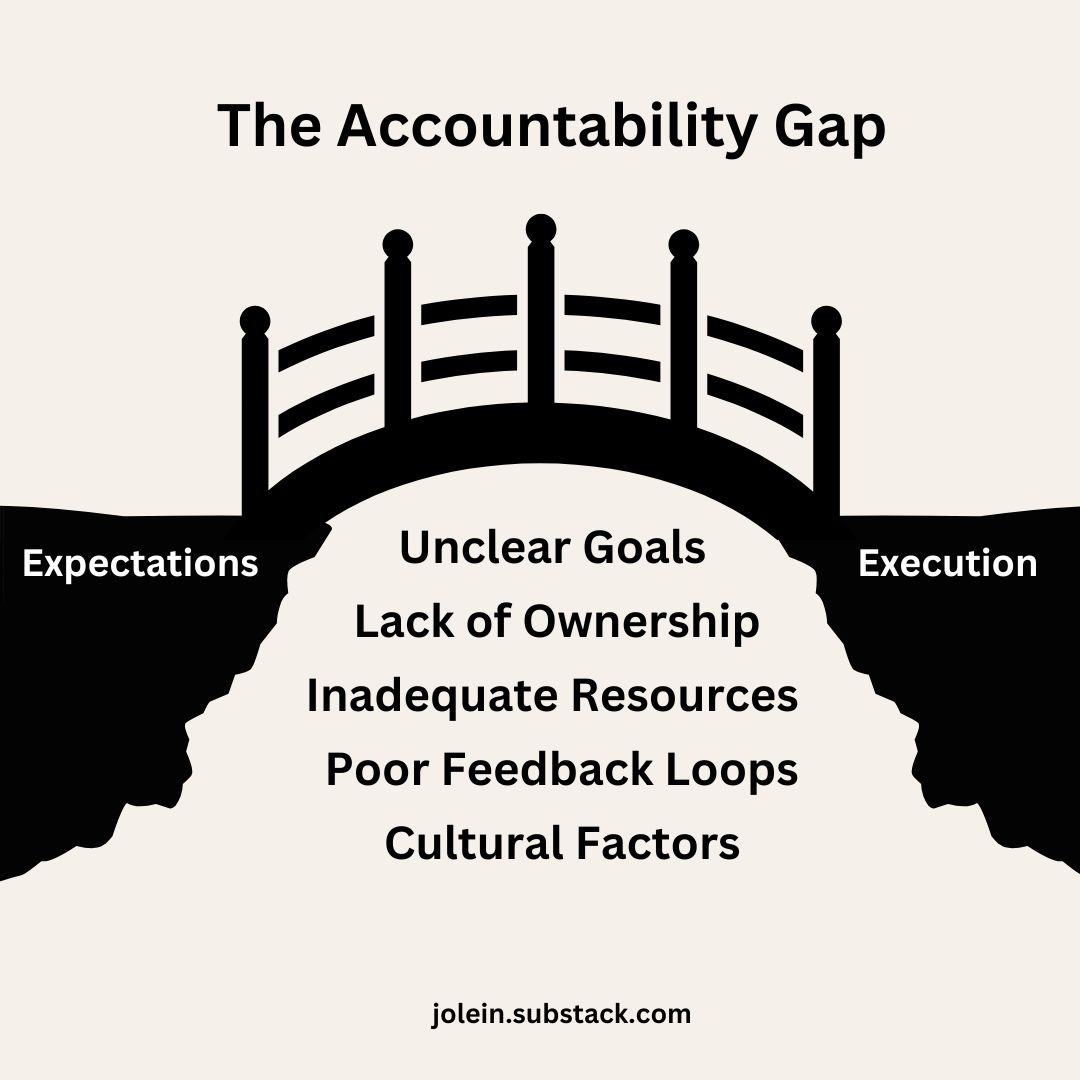The Accountability Gap refers to the disconnect between expectations and execution. It occurs when individuals, teams, or organizations fail to meet their commitments due to unclear communication, lack of follow-through, or systemic barriers. The Accountability Gap is everywhere in public education—from the classroom to the district office. It’s where well-intentioned plans fall apart.
It’s not about blame—it’s about addressing the breakdowns that keep us from achieving what we know is possible.
Causes of the Accountability Gap
Common causes of the gap include:
Unclear Goals: Ambiguity about the “what” and “why.”
Lack of Ownership: Responsibility feels distributed rather than personal.
Inadequate Resources: Lack of tools, time, or training.
Poor Feedback Loops: No tracking or alignment over time.
Cultural Factors: Fear of blame, competing priorities, or low trust.
1. Unclear Goals
Ambiguity about the “what” and “why” prevents progress. If people don’t know exactly what’s expected, they can’t deliver.
Example 1: A student is assigned a group project with vague instructions, such as “be creative.” Without clarity on the outcome or criteria for success, students struggle to focus and produce uneven results.
Example 2: Teachers are told to “increase engagement,” but they have not explained what engagement looks like or how to measure it. They resort to guesswork, which leads to frustration when their efforts go unrecognized or unaligned.
Question for Reflection:
What specific outcome am I expecting, and how will I know it’s been achieved?
Have I clearly communicated the purpose and criteria for success to all involved?
2. Lack of Ownership
When responsibility is distributed rather than personal, tasks slip through the cracks.
Example 1: A group of students is assigned a collaborative project, but no one takes responsibility for specific parts. Deadlines are missed, and the final product reflects the lack of ownership.
Example 2: A professional learning community (PLC) agrees to analyze data but doesn’t assign specific roles for who will collect, organize, or present it. No one has made progress in the next meeting, and tension builds.
Example 3: A principal announces a new attendance initiative but doesn’t designate someone to track data or follow up with chronically absent students. Attendance rates stay stagnant because no one feels responsible.
Question for Reflection:
Who is ultimately responsible for ensuring this task or goal is completed, and do they know it?
Am I fostering an environment where people feel empowered to take ownership or is responsibility being passed around?
3. Inadequate Resources
Lack of time, tools, training, or authority creates barriers to execution.
Example 1: A teacher is told to implement project-based learning without materials, professional development, or planning time. This results in burnout and ineffective lessons.
Example 2: A school adopts a new reading intervention program but doesn’t allocate enough staff or schedule time for its implementation. Teachers abandon the program out of frustration.
Question for Reflection:
What resources (time, tools, training, or support) might be missing that could prevent success?
Have I proactively addressed any potential obstacles or gaps for those involved in this work?
4. Poor Feedback Loops
Without consistent tracking and alignment, progress stalls, and people feel disconnected from their goals.
Example 1: A student works hard on improving their math skills but receives no feedback on progress for weeks. Without timely reinforcement, their motivation declines.
Example 2: A teacher submits lesson plans for review but gets no feedback from their instructional coach. They aren’t sure if their work is on track or needs adjustment.
Example 3: A school introduces a behavior management system but doesn’t analyze referral data or share trends with staff. Teachers lose faith in the system because it feels ineffective and disconnected from daily realities.
Questions for Reflection:
Am I providing timely, specific, and actionable feedback to keep this on track?
What system or process can I use to monitor progress and align expectations regularly?
5. Cultural Factors
Low trust, fear of blame, or competing priorities prevent people from engaging fully.
Example 1: Teachers avoid admitting they’re struggling with classroom management because they fear being labeled ineffective. This fear prevents them from seeking support or improving.
Example 2: Teachers at a school are reluctant to report issues with a new initiative because they’ve experienced backlash in the past. This culture of fear leads to unaddressed problems and implementation failure.
Example 3: A district rolls out an ambitious strategic plan but fails to prioritize tasks, leaving schools overwhelmed by competing demands. Without clear priorities, nothing gets done well.
Question for Reflection:
Am I fostering a culture of trust where individuals feel safe to take risks or admit challenges?
How can I ensure priorities are clear and competing demands are minimized to support focus and follow-through?
The Accountability Gap is a universal challenge that extends far beyond public education. It’s the reason why New Year’s resolutions fizzle out by February, why team projects stall despite countless meetings, and why promising initiatives fail to deliver. The gap thrives in ambiguity, misplaced responsibility, insufficient support, and fractured communication.
However, acknowledging these causes is the first step toward bridging the gap. Whether we’re talking about a student who struggles to follow classroom expectations, a teacher left unsupported with new curriculum requirements, or a district initiative that loses momentum, the solution lies in clarity, ownership, resources, and trust.
This isn’t about assigning blame—it’s about building systems and cultures that support follow-through, foster collaboration, and close the gap between intention and impact. Because when we address the root causes, we don’t just improve outcomes; we empower individuals and teams to achieve what we all know is possible.
What’s one gap you can start closing today?
Part 3 coming soon!







Thank you Jo. This is really interesting but sadly in schools this accountability gap is common. Directives and policies get rushed through with little discussion. Teachers are given vague directions and little support to implement them.